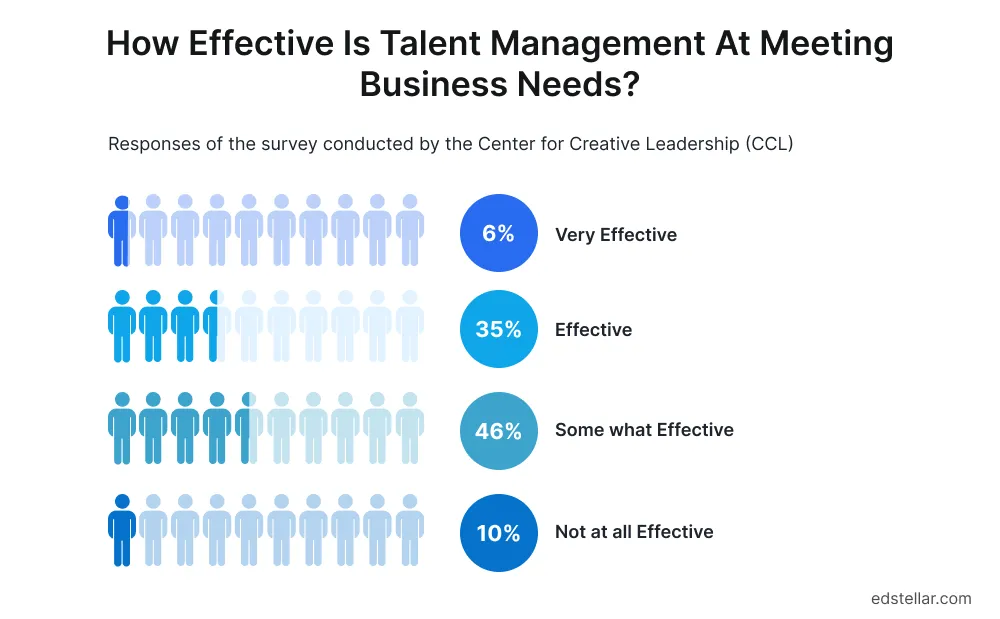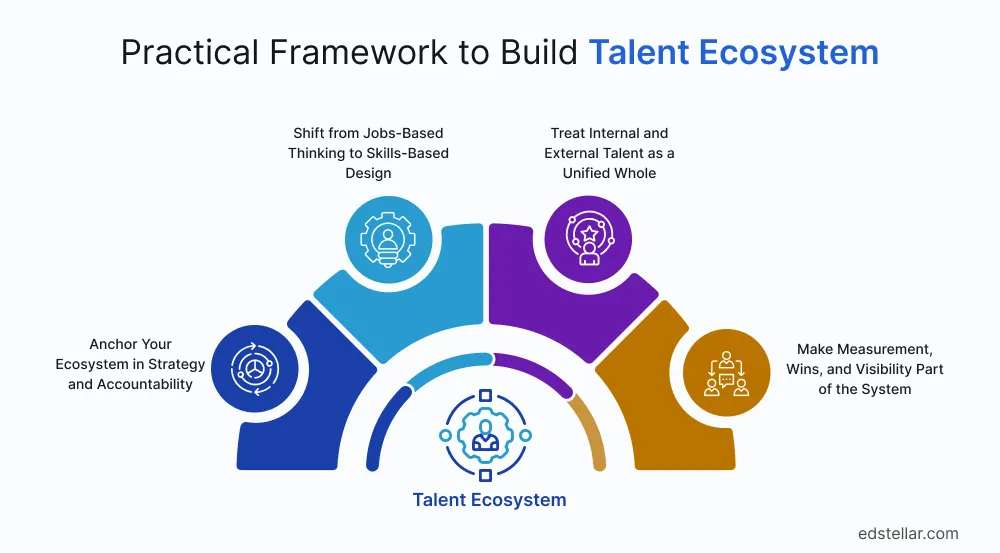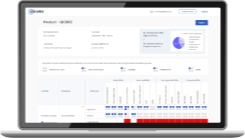
The traditional talent management model is breaking down, and forward-looking organizations are turning to dynamic, skills-first talent ecosystems to stay competitive in today’s AI-powered world of work. As intelligent automation accelerates, teams decentralize, and work shifts toward fluid, project-based structures, organizations need not only new skills but new strategies for how those skills are discovered, developed, and deployed.
Yet despite growing awareness of these shifts, many organizations are falling behind, struggling with fractured teams, outdated workforce models, and rising frontline burnout. From 2016 to 2022, productivity growth in advanced economies dropped to just 1%. In the U.S., 71% of manufacturers cite workforce instability as a core operational challenge. Beneath the surface, five structural fault lines are driving the disruption:
- Acute talent shortages
- Rapidly widening skill gaps
- Evolving worker expectations
- Overburdened frontline managers
- Weak recognition and reward systems
Externally, the talent market is no less volatile. According to a 2023 ManpowerGroup study, 77% of employers report difficulty filling roles. Many are responding by tapping into contingent workforces. In 2022, at least 30% of work in half of the surveyed organizations came from contractors or freelancers, with the figure rising to 40–50% in the tech sector, according to MIT Sloan Management Review.
To adapt, leading companies are embracing open talent models, building agile benches of vetted contractors who can be deployed on demand. Internally, they’re unlocking capacity through flexible mobility programs that allow employees to shape their own schedules and contribute to cross-functional projects tied to learning and growth goals.
These dual shifts, external sourcing and internal mobility, signal a broader need to rethink how talent is managed, valued, and activated across the enterprise.
Despite spending nearly three times more on talent than on capital equipment, most organizations don’t manage their workforce investments with the same level of discipline, foresight, or strategic rigor. This imbalance is no longer sustainable.
To close this gap, pioneering organizations are embracing ecosystem thinking, designing interconnected, adaptive, and capability-rich talent models that align people strategy with business value. A signal of this shift comes from the World Economic Forum, which piloted talent innovations across 13 industrial sites and reported tangible results:
- 52% improvement in workforce stability
- 34% improvement in financial performance
- 28% improvement in productivity and operational safety
While not every organization will replicate these exact outcomes, the evidence is clear: talent strategy, when approached holistically and embedded within broader transformation, delivers measurable and lasting impact.
The takeaway is simple yet powerful: building a talent ecosystem isn’t aspirational, it’s operationally essential. One that puts people at the center of transformation.
In the sections ahead, we’ll unpack what a talent ecosystem really is, why HR and L&D leaders are shifting toward this model, how to build one using a practical framework, and the real-world impact it can deliver.
What Is a Talent Ecosystem?
A Talent Ecosystem is a dynamic, interconnected network of people, processes, technologies, and strategies that collectively govern how talent flows into, within, and out of an organization. As Allen Larson, VP of Recruiting Strategy & Enablement at Nelson Connects, puts it:
At first glance, that may sound familiar. After all, many HR leaders already have robust ATS platforms, LMS systems, and mobility initiatives in place. But a tech stack does not equal an ecosystem. What distinguishes a Talent Ecosystem is not just the tools you use but the strategic cohesion, talent visibility, and ongoing adaptability that tie it all together.
In many organizations, HR oversees internal talent, while procurement or department heads independently manage external resources, such as contractors, freelancers, and gig workers. And in some cases, managers bypass formal processes entirely, simply because they don't feel equipped with the right support. It's not a failure of intent; it's a sign of fragmentation.
And this is where most organizations quietly start to lose visibility.
Disconnected systems lead to siloed decision-making. Valuable skills go unnoticed. Internal career paths stagnate. External hires fill gaps that internal mobility could have addressed.
That's why the ecosystem is essential. It brings everything under a single, connected lens. And it requires HR to reframe its own identity from a compliance gatekeeper to a value-creating enabler.
As Michael Shipman, Coach and Consultant at Michael Shipman Coaching and Consulting, puts it:
To build a thriving talent ecosystem, we need to enroll managers as talent scouts, reimagine HR as a talent agency, and empower leaders to serve as active mentors.
- Creating A Sustainable Talent Ecosystem
This mindset shift positions HR as the architect of a system where talent can flow fluidly across the organization, wherever it's needed most.
A true Talent Ecosystem provides HR leaders with a full line of sight, not just into job openings, but also into real-time skills data, potential for internal growth, leadership readiness, and access to talent sources both inside and outside the organization. It acknowledges that talent is a corporate asset, and like any asset, it must be managed strategically and holistically.
At its core, a Talent Ecosystem is defined by four critical attributes:
- Interconnectedness: Talent strategies, systems, and stakeholders operate in sync, not silos. (Think: shared data platforms, unified workflows, cross-functional accountability.)
- Adaptiveness: The ecosystem evolves with changing market dynamics, skill demands, and internal business shifts.
- Lifecycle Integration: It encompasses the entire talent journey, spanning from attraction and onboarding through development, succession, and exit.
- Data-Driven Intelligence: Decisions are informed by real-time insights into skills, performance, potential, and market availability.
Therefore, embracing this model enables talent management to transition from a reactive function to a strategic advantage. It's how we shift from simply managing people to enabling performance, agility, and sustainable growth.
Why HR Leaders Must Shift Toward a Talent Ecosystem Approach
According to a global survey by the Center for Creative Leadership (CCL), only 6% of organizations rated their talent management systems as “very effective” at meeting business needs. Nearly half (46%) called them “somewhat effective,” and another 10% admitted they were “not at all effective.”
That means more than half of HR leaders surveyed believe their current systems are failing to deliver the value their organizations need.
This data reveals three critical truths:

1. Talent Systems do Deliver Value, but Only for Some: Roughly half of organizations are seeing reasonable outcomes from traditional systems. It shows that structured talent management, when done well, does contribute to business success.
2. But the other Half are Struggling: Many HR leaders report limited returns from existing systems. That’s not just a technology issue; it points to broader misalignment across people, processes, and visibility. It’s no longer enough to focus on siloed activities like performance reviews, headcount planning, or standalone L&D programs.
3. Many Leaders Lack Visibility into what’s Working: Some respondents couldn’t even gauge their systems’ effectiveness. That “missing link” often stems from a lack of metrics, weak feedback loops, or disconnected tech platforms. If you can’t measure how your talent strategy fuels outcomes, you’re flying blind.
What Sets a Talent Ecosystem Apart:
The ecosystem approach isn’t about discarding your LMS, ATS, or talent dashboards; it’s about rethinking how they interact, interoperate, and inform decisions across the entire talent lifecycle. A learning system that isn't connected to internal mobility insights is merely content delivery. An ATS that doesn’t inform long-term capability planning is merely a resume sorter. These tools, on their own, are insufficient.
What defines a Talent Ecosystem is the unification of these components into a working system that gives HR real-time visibility into who your people are, what they can do, where they can grow, and how they impact outcomes. It’s about aligning talent acquisition with internal reskilling. Connecting gig workers to long-term project needs. Matching succession plans to current leadership pipelines. All of it mapped, monitored, and managed as one.
Organizations that operate this way aren’t just reacting to skills gaps or market shifts. They’re anticipating them, reallocating resources faster, designing learning journeys that fit future roles, and fostering a workforce that feels seen, supported, and ready to move. That’s the real power of ecosystem thinking: it turns HR into an orchestrator, not just a responder.
And in a world where only 6% say they’ve mastered this? That’s your competitive edge.
A Practical Framework to Build Your Talent Ecosystem
So, how do you move from fragmented talent management to a true talent ecosystem?
The path forward isn't about adding one more system or launching a new initiative. It's about re-architecting how talent is discovered, developed, deployed, and connected across your organization, whether internal or external. The frameworks below give HR leaders a practical blueprint to get started.

1. Anchor Your Ecosystem in Strategy and Accountability
Building a talent ecosystem begins with alignment. Every initiative, whether it's internal mobility, contingent workforce planning, or leadership development, must tie back to business strategy.
As Michael Shipman noted, "If you're not connecting it to the strategy, it's going to be tough to get funded for your talent initiatives."
This is a reality most CHROs know too well. Talent, in today's landscape, is no longer a supporting function; it's the driver of innovation, speed, and resilience.
Establish clear ownership across stakeholder roles:
- Talent Overseers (Board & C-Suite): Hold leadership accountable for aligning talent decisions to long-term goals. Review succession pipelines annually and track the performance of high-potential talent.
- Talent Orchestrators (CEO & Senior Leaders): Model cross-functional talent sharing. Encourage stretch assignments and directly mentor emerging leaders.
- Talent Influencers (Line Managers): Identify future leaders early. Collaborate with HR to co-own development roadmaps and succession strategies.
- Talent Accelerators (HR & L&D): Design the system, connect the dots, and engage leaders consistently. Cultivate a culture where talent conversations happen continuously.
- Talent (Employees): Encourage employees to own their development journey. Help them set career goals, voice their aspirations, and access meaningful learning pathways.
An ecosystem cannot thrive unless everyone has a role to play and is accountable for playing it.
2. Shift from Jobs-Based Thinking to Skills-Based Design
Talent ecosystems don't run on job titles; they run on skills. That means moving away from rigid org charts and static roles to fluid skills architectures.
In skills-based ecosystems:
- Projects are broken down into tasks
- Managers search for people with the exact skills needed, not just job descriptions
- Internal and external talent are matched to work based on real capabilities, not tenure or legacy roles
This approach unlocks agility. If the skills aren't available internally, vetted freelancers or contractors can be quickly brought in. It also expands opportunity for internal talent, someone in customer service may have project management skills you didn't know about.
To make this work, you need:
- A unified skills database that includes both employees and contractors
- Visibility into which skills are in surplus, emerging, or critical
- Integration of learning platforms with real-time skill tracking and project allocation tools
It's not about managing jobs anymore, it's about mobilizing skillsets at speed.
To dive deeper into how this mindset shift works in practice, explore our guide on the Skills-First Approach.
3. Treat Internal and External Talent as a Unified Whole
One of the most important shifts in ecosystem thinking is recognizing that all talent, whether permanent, freelance, gig, or contract, is part of a single workforce model.
In most companies today, full-time employees and contractors are managed separately. That creates friction, inefficiency, and siloed performance. Contractors may lack context. Employees may resent perceived inequality. The result? A fragmented workforce culture.
A talent ecosystem corrects this by:
- Using a single system to oversee both internal and external talent
- Giving managers clear guidelines on how and when to bring in external support
- Ensuring external talent contributes not just to execution, but to internal capability building
- Making gig talent visible in the same dashboards and planning systems used for employees
When contractors are treated as partners, not stopgaps, they become valuable contributors to long-term outcomes.
To build this unified workforce model effectively, it helps to start with a well-managed, forward-looking talent pool strategy that aligns with your ecosystem goals.
4. Make Measurement, Wins, and Visibility Part of the System
Ecosystems thrive on feedback loops. You can't manage what you don't measure, and you won't get buy-in if you can't show impact.
It starts with going beyond standard HR metrics. Instead of just tracking time-to-fill or completion rates, measure:
- How talent initiatives are solving real business problems
- How skill development efforts are closing capability gaps
- How internal mobility is accelerating project speed and reducing attrition
And don't keep wins quiet.
Report outcomes publicly. When leaders see that a high-visibility project was delivered faster because of internal redeployment, or that reskilling filled critical roles without external hires, they'll want in.
That visibility is what earns you a seat at the table and sustained investment in your ecosystem.
Bringing It All Together
This is how ecosystems are built: not through a one-time overhaul, but through a shift in how talent is viewed, deployed, and supported.
- Tie every initiative to strategy
- Design around skills, not jobs
- See all talent as one unified pool
- Create a system of feedback, visibility, and shared wins
When implemented right, a talent ecosystem doesn't just manage work; it accelerates business readiness for what comes next.
Case Study 1: Transforming Talent Management in Semarang’s Manufacturing Sector
In the Semarang Regency of Indonesia, local manufacturing companies confronted a significant barrier in adapting to Industry 4.0: their talent management practices remained traditional and were ill-equipped to handle the demands of digital transformation.
These companies primarily relied on rigid, centralized HR systems where all talent decisions were made top-down by HR departments. Talent mobility was limited, and internal development efforts lacked alignment with the evolving demands of industrial automation, robotics, and other disruptive technologies brought on by Industry 4.0.
Recognizing this gap, the companies initiated a shift away from fragmented, conventional systems toward a more ecosystem-oriented model of talent management. This transformation began by decentralizing HR authority. HR managers were no longer the sole decision-makers; they became facilitators who worked alongside line managers and department leaders to identify talent needs and co-manage development planning.
Line managers were empowered to take ownership of developing and deploying talent within their units. The shift involved implementing more dynamic job role definitions, adjusting recruitment strategies to focus on adaptability and cross-functional potential, and introducing structured internal mobility mechanisms.
Importantly, employees were given a more active role in their development journey. Rather than being passive recipients of training programs, they were encouraged to communicate aspirations and actively participate in identifying their learning needs, anchored to organizational goals.
The transformation delivered clear results. Companies reported increased flexibility in workforce deployment, greater alignment between skills and operational needs, and improved responsiveness to digital and automation-related challenges.
This case demonstrates how a shift toward a collaborative, decentralized, and skill-aligned talent ecosystem can empower manufacturers, even those starting from traditional HR models, to better meet the future of work.
Case Study 2: IBM’s Shift from Fragmented Talent Practices to a Unified Talent Ecosystem
In the early 2000s, IBM was managing talent through multiple disconnected systems and region-specific approaches. Each business unit had its own processes for workforce planning, recruitment, development, and succession, creating a fragmented experience across the organization. As IBM expanded globally and began facing increasing demand for high-skill talent in emerging markets, this decentralized model began to show serious cracks.
IBM leaders recognized the lack of alignment between global strategy and local talent decisions. They were unable to scale critical skills fast enough or track global leadership pipelines effectively. Moreover, decision-makers lacked real-time visibility into the organization’s skills and workforce capabilities, making it difficult to match talent with opportunities across geographies.
To address this, IBM undertook a major transformation. They introduced a globally integrated talent management system built on three pillars:
- Integrated Infrastructure: IBM developed centralized platforms and shared service centers to manage workforce data, learning systems, and career planning tools. This allowed for seamless tracking and redeployment of talent globally.
- Skills and Capability Frameworks: They adopted a common language and taxonomy to define skills and roles across the business. This helped managers assess gaps and identify internal talent for new initiatives.
- Predictive Analytics: IBM applied advanced analytics to forecast talent demand, optimize leadership development, and personalize learning. For instance, their analytics tools could identify high-potential employees at risk of leaving, triggering proactive interventions.
This transformation led to a significant business impact. IBM gained:
- Better alignment between workforce capabilities and business strategy
- Faster deployment of talent across borders and projects
- Greater retention and engagement of high-potential employees
- Stronger leadership bench strength for emerging markets
IBM’s shift modernized its HR operations, turning workforce strategy into a competitive differentiator that ensured talent could flow fluidly across the enterprise, wherever and whenever needed.
Frequently Asked Questions
Building Your Talent Ecosystem Starts Now
The future of talent isn’t just about acquisition, it’s about activation, agility, and alignment. In a world where business priorities change overnight and skill demands shift faster than ever, static workforce models simply can’t keep up. What organizations need today is a dynamic system, one that sees people as a network of evolving capabilities rather than fixed roles.
At Edstellar, we help organizations design and sustain that very system.
As a trusted corporate training provider, Edstellar empowers HR and L&D leaders to transform how they manage, develop, and deploy talent. Our specialized Skill Matrix software enables you to map workforce capabilities, uncover hidden skill gaps, and design learning interventions tailored to business outcomes. Whether you’re building a leadership pipeline, preparing for automation, or scaling a global workforce, we bring the insight and tools needed to make it happen.
Through our L&D consulting, skills-based training programs, and platform-driven diagnostics, we enable you to lay the foundation for your own talent ecosystem, one that’s flexible, future-ready, and fully aligned to your strategic goals.
Ready to rethink how your organization manages talent?
Contact us today to start building your talent ecosystem with Edstellar by your side.
Explore High-impact instructor-led training for your teams.
#On-site #Virtual #GroupTraining #Customized

Bridge the Gap Between Learning & Performance
Turn Your Training Programs Into Revenue Drivers.
Schedule a ConsultationEdstellar Training Catalog
Explore 2000+ industry ready instructor-led training programs.

Coaching that Unlocks Potential
Create dynamic leaders and cohesive teams. Learn more now!


Want to evaluate your team’s skill gaps?
Do a quick Skill gap analysis with Edstellar’s Free Skill Matrix tool

Transform Your L&D Strategy Today
Unlock premium resources, tools, and frameworks designed for HR and learning professionals. Our L&D Hub gives you everything needed to elevate your organization's training approach.
Access L&D Hub Resources.svg)
.svg)



.svg)


.svg)
.svg)
.svg)
.svg)

